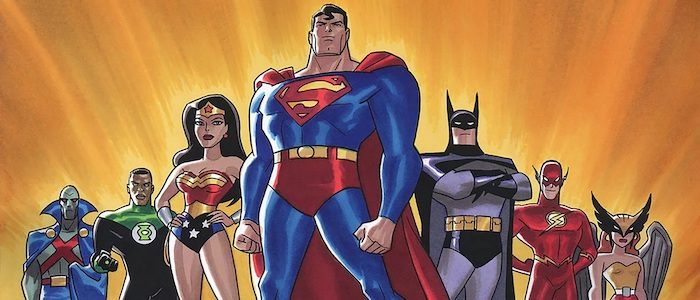
Zack Snyder’s Justice League hit HBO Max last week, delivering a darker and edgier take on the DC superhero team. The filmmaker’s directors cut is the result of a rallying cry from a loyal sect of fandom, who campaigned to see Snyder’s official vision so the world could finally get the definitive Justice League movie they’d been waiting for.
However, what fans may not know is they can already watch the best, most definitive version of the Justice League on HBO Max right now with the DCAU animated shows Justice League and Justice League Unlimited.
This year marks the 20th anniversary of the Justice League animated series, the grand culmination of Bruce Timm’s DC animated universe (or DCAU) which started a decade prior with Batman: The Animated Series. The success of Batman eventually paved the way for Superman to get his own animated series and share multiple crossovers with his Gotham neighbor. Timm’s next project was the ambitious Batman Beyond, which took place 20 years after the events of Batman: The Animated Series, in which a darker and techno-punk Gotham became the home of a newer, younger Batman, Terry McGinnis, mentored by an older Bruce Wayne. The Timmverse culminated in DC’s flagship title, Justice League, where Batman and Superman would enlist fellow heroes Wonder Woman, The Flash, Green Lantern, and the Martian Manhunter to protect the Earth from their ever-growing rogues’ gallery in an orbiting Watchtower in space. The show would later rebrand itself after two seasons as Justice League Unlimited, and the roster would expand to almost every DC superhero imaginable. The show was inspired by Grant Morrison’s run on the JLA comics and even had episodes scripted by several prominent comic writers, including J. M. DeMatteis, Gail Simone, Warren Ellis, and the late Dwayne McDuffie, the latter of whom would later become the main writer and architect of Justice League Unlimited.
Not only is Justice League one of the finest superhero adaptations in any medium, but it remains one of the best animated shows of the last 20 years, leaving an everlasting impact on the comic book universe and animation as a whole. I know there’s a crop of new comic book fans sprung from the recent boom of the Marvel and DC cinematic universes who were likely not old enough or just missed out on Justice League when it first aired. But thanks to HBO Max, both shows are now streaming and I want to share what I think are the best of the best the show had to offer. While the first two seasons of Justice League featured mostly stand-alone two-parter episodes, when it came back as Justice League Unlimited, it followed a more traditional serialized format with arcs spreading across multiple episodes.
This is not an essential fast track of episodes, since I advise anyone who hasn’t seen the show to watch it straight from the beginning. But here are the 15 best episodes of Justice League and Justice League Unlimited.
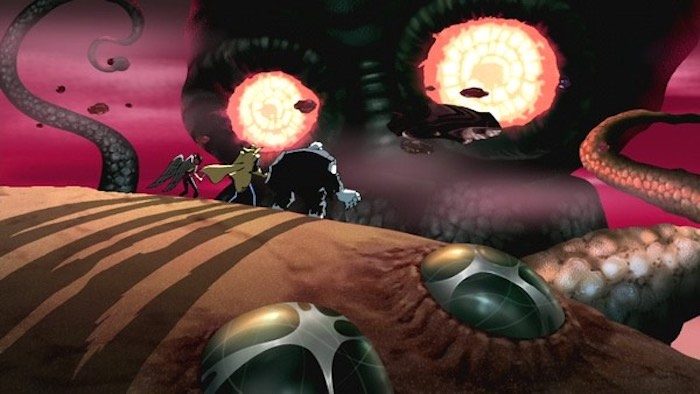
15. “The Terror Beyond” – Justice League, Season 2
Everyone knows the Justice League’s most fearsome villains: Lex Luthor, The Joker, Gorilla Grodd, Darkseid, Cthulhu. Wait. What? Yes, there is an entire episode dedicated to the Old One itself and the League goes toe-to-toe with ole squidface in one of the more tear-jerking Justice League episodes. Oh, did I mention Cthulhu is voiced by Rob Zombie? Buckle in folks, it’s a wild episode. You’ll be surprised to know “The Terror Beyond” is a loose adaptation of a Marvel storyline featuring the Defenders as they battle the Undying Ones. The Defender team of Namor, Doctor Strange, and Hulk are rendered as Aquaman, Doctor Fate, and Solomon Grundy who are later joined by Superman, Hawkgirl, and Wonder Woman. The parallelism doesn’t end there as the episode begins with a Thunderbolt Ross-like commander trying to capture an out-of-control Grundy before he is rescued by Aqua-Namor riding a giant sea-serpent. Aquaman needs Grundy, who is essentially a walking deadman, to be sacrificed in a ritual performed by Doctor Fate to prevent the coming of Icthulhu (writer Dwayne McDuffie wanted to use the name Cthulhu but assumed he couldn’t have gotten the rights though; he could have as the name is in the public domain).
What I love about “The Terror Beyond” is two things really: One, it introduces us to Dr. Fate, one of the best and slickest designed Justice Leaguers the show has to offer. He lives in a stone monument called The Tower of Fate alongside his wife, Inza, as he welcomes lost souls in need of purpose. He’s an awesome addition and would be more prominent in Justice League Unlimited and in non-DCAU shows, The Brave and the Bold and Young Justice. Two, all the Lovecraftian imagery on display is a joy to behold. When the heroes enters Icthulhu’s realm, up becomes down as they try to traverse this nightmare void, battling creatures who have mouths in their hands (this leads to one of the episodes best lines where Grundy shouts “GRUNDY HATE SCREAMING MAN!”). Icthulhu’s Terror enters Aquaman’s domain as a horde of unspeakable creatures rage war against Aquaman in a fantastic underwater battle.
Solomon Grundy is an interesting character to headline an episode around, as he’s mostly a rampaging vegetable with a limited vocabulary. He flexes between friend and foe throughout the series, but he carries a softness that attracts Hawgirl in one of the show’s more unique and compassionate friendships. Underneath all the Lovecraftian insanity the episode throws at us, this is a sweet tender episode about Hawkgirl coming to a realization about faith and sacrifice. Hawkgirl’s people, the Thanagarians, used to worship the Old Ones and then stop believing in them, which pissed off the mighty Icthulhu. Grundy, who remembers he used to be an old west vigilante who was brutally murdered, wants his soul back and believes Icthulhu has it. Bringing faith to a kid’s show is always a tricky tightrope act, but McDuffie performs it gracefully in showing an understanding between having faith in a higher power versus a faith in being a strong-willed person.
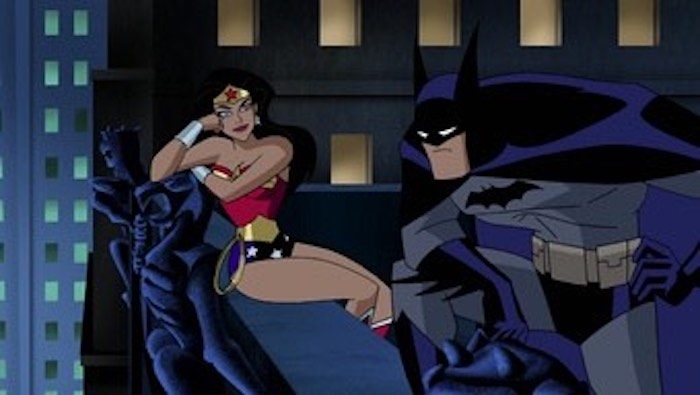
14. “This Little Piggy” – Justice League Unlimited, Season 1
I don’t know what it says about me that my favorite DC movie of the past decade is Teen Titans GO! To the Movies. Alongside The LEGO Batman Movie, the movie is earnest about how goofy it is, and understands in order to poke fun at your own genre, you have to truly love it first. Ever since DC took a more “darkness, no parents” approach to its slate of movies, it has sparked a cultural war among comic book fans in how overly serious they want their superhero movies to be. Let’s face it, comic books are inherently silly. They’re fun escapist stories about people with extraordinary abilities who wear ridiculous costumes to fight bad guys who wear even more ridiculous costumes. The beautiful thing about the comic book industry is it’s wide enough for all writers and artists to play around with these characters without there being one, true “correct” way to tell a story about a man who dresses like a bat. I can love The Dark Knight Returns and the ‘60s Batman show on equal terms. Justice League Unlimited understands that tonal balance better than many, which is why it can shift from a serious episode like “For The Man Who Has Everything” to “This Little Piggy,” where Wonder Woman turns into a pig and Batman sings the blues.
“This Little Piggy” is one of Justice League Unlimited’s lightweight episodes alongside “Kid’s Stuff” and “The Greatest Story Never Told.” It’s a divisive episode amongst fans primarily for its ridiculous premise and the way it defies normal conventions. If you’re all into the Snyderverse aesthetics of how superhero stories should be like, this episode is likely not going to appeal to you. Superhero animation legend Paul Dini returns to write this one after his delightful “Comfort and Joy,” but “This Little Piggy” is full of his trademark Dini-isms. Let’s see what we got: Lots of Zatanna? Check. Being horny on main? Check. Unused background characters getting their moment in the spotlight? Check. Not one, but TWO musical numbers? Oh yeah, this is a Dini episode alright. There’s nobody else other than Paul Dini I would trust to make an episode this wacky given his years of experience writing in this universe. This episode doesn’t work unless you have the developing relationship between Batman and Wonder Woman established earlier on in the series. Diana clearly wants to move to the next level, but Batman explains that dating within the team leads to disaster and an immortal princess and a rich kid with issues’ don’t pair well. Of course Diana thinks he’s full of shit. When Diana gets transformed into a pig by the sorceress Circe, Batman enlists the help of his old friend Zatanna to reverse the spell. When her attempt fails, they turn to other measures, but still try to keep the League from finding out about Wonder Pig.
It’s a wild episode. Wild as in Batman takes a trip to Tartarus and meets Themis, who brings in Circe’s former roommate, a chain-smoking Medusa, who offers to reveal the location of Circe in return to shave off 300 years from her sentence. Wild as in bringing in animal tracker extraordinaire B’wana Beast, who flirts with Zatanna and chatters up with pigs in a pork processing plant. Wild as in Wonder Pig deflects a shotgun blast with her golden pig bracelets. You get the idea. All of this climaxes in a musical number where Kevin Conroy gets belt out his pipes like never before. Is this episode ridiculous? Sure, but it’s also entertaining and is a fun reminder that every episode doesn’t need to deal with Darkseid taking over the world. Sometimes you just need a nice story about a bat and his pig.
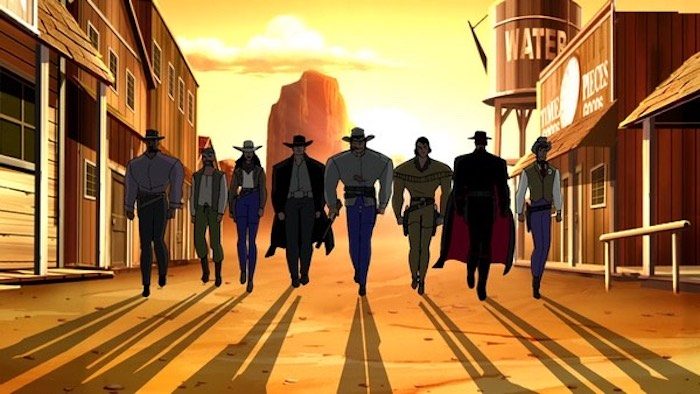
13. “The Once and Future Thing” – Justice League Unlimited, Season 1
Justice League shows loves to end their first seasons with crazy time travel adventures. For their first season one finale, the League was sent forward to a distorted future where the Axis won World War II and now have to go back in time and correct history from the immortal and new Fuhrer Vandal Savage. In Justice League Unlimited’s season 1 finale (the only two-parter in JLU’s three seasons), time travel takes our heroes to the Wild West of 19th century Oklahoma and then 50 years forward into a familiar-looking future Gotham. I love time travel stories, especially within the comic book world, because you don’t have to think too hard about the logic and it’s a fun excuse for characters to bump into characters they wouldn’t normally meet.
The first part, “Wild Western Tales,” has Green Lantern, Batman, and Wonder Woman chasing after a lowly two-bit thief named David Clinton who uses time travel to steal artifacts throughout history to impress his nagging wife. Clinton attempts to steal Batman’s utility belt, but he gets caught and they get sucked into a time portal taking them back to the Wild West. This allows the trio, now all spurred and saddled up, to team up with All-Star Western heroes such as Jonah Hex, Bat Lash, El Diablo, and Ohiyesa “Pow Wow” Smith. There’s lots of fan service on display, rewarding old school comic book readers by showing love to an unsung group of heroes confined to a specific time when Westerns were the superhero stories of yonder. Dwayne McDuffie dives headfirst into this Western sandbox, creating a fun throwback playing with all the familiar tropes, including our heroes riding out set to a classic Elmer Bernstein riff on the Justice League theme. Of course this being a time travel story, there’s some time-ripping shenanigans like cowboys riding dinosaurs and robots with top hats to keep our heroes on their toes before they set off to their next destination.
The second time-jump takes Batman, Wonder Woman, and Green Lantern into the future, where the only remaining survivors of the league are Batman (Terry McGinnis), Static, and Warhawk. Upon seeing John Stewart, Warhawk lets out a cry of “Dad?”, revealing he is the future son of John and Shayera. Experiencing the Batman Beyond universe once again is a great surprise for DCAU fans, especially seeing the return of the Jokerz, a homicidal gang seen only in the excellent DCAU movie, Batman Beyond: Return of the Joker. While riding high in the Old West had its blend of action and humor, part two carries higher stakes and a darker tone, as Clinton (or Lord Chronos as he now calls himself) messes up with the space-time continuum where the universe starts to fade out of existence. There’s still a lot of fan service-y moments, like Batman playing good-cop-bad-cop with his older self and John Stewart time-shifting into a fan-favorite Lantern corps. Executing fan service can be tricky, especially in a comic book adaptation where it’s expected, without being overly gratuitous. The show finds balance between giving what the fans want while also making sure it makes sense in the story they want to tell. There’s no “wink-wink” or elbow-nudging done here. It’s all out of genuine love for the characters and their stories.
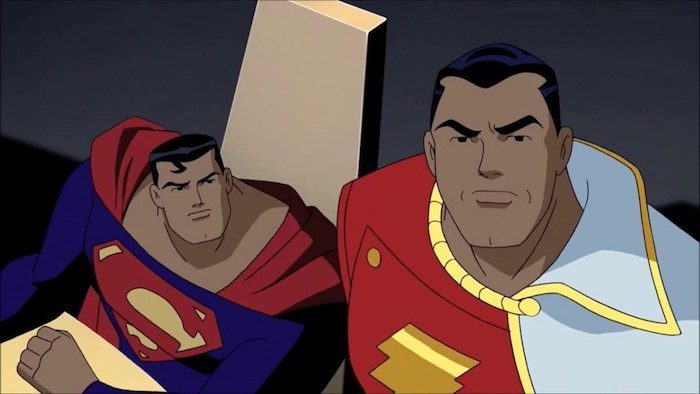
12. “Clash” – Justice League Unlimited, Season 2
What makes Lex Luthor such a formidable foe for the Justice League? A single punch by Superman would end him, but nevertheless he still finds himself at the top of the villain hierarchy. Sure, he sometimes battles in a nanotech robot suit, gets super strength, or merges with Brainiac to be a more physically opposing opponent, but his greatest strength has always been his mind. He takes joy in manipulating the “Truth, Justice, and American Way” ideals of the League by taking the line they struggle not to cross and smearing his foot over it. Clancy Brown is the quintessential Luthor, who doesn’t need a jar of piss to be threatening, as his study tenacity and smooth demeanor is enough to find the perfect balance of charm and menace. He’s been the bedrock of the entire series, creating the schism between the trust between League and the people they have sworn to protect.
“Clash” happens on the eve of the Cadmus arc, and there’s no better time to light the fuse by introducing Captain Marvel (or Shazam as he is now referred to) to hold a mirror up to Superman. Captain Marvel is actually a young boy named Billy Batson, who shouts “shazam!” to turn into a superhero with strength rivaling Superman. While he grows in size, he still has a child-like view of the world, and has all the boy scout characteristics normally associated with Clark. Captain Marvel can’t see beyond black and white, and believes Luthor has changed for good, endorsing his run for president, which sets alarms off for the League, especially Superman. They believe the League should remain neutral and stay out of politics (yet politics keeps finding a way to stay with the League). Luthor uses this rift to stage a charitable event for his new project “Lexor City,” which promises affordable housing for low-income families. When Superman attends, he scans a mysterious device with a timer ticking down several floors below the surface. Luthor says it’s nothing but a power generator, but Superman doesn’t buy his bullshit, which leads to the titular clash between Captain Marvel and Superman.
Boy, this fight is brutal and it’s hard to root for Superman as he pummels Captain Marvel to pieces, unaware they are mere pawns in Luthor’s grand chessboard. The brawl is everything Lex wanted, a showcase of how violent these super-powered individuals can be as they level all of Lexor City (all purposely evacuated). Dan Riba’s direction makes sure you feel every punch and blow and even homages the two fighting in the comic Kingdom Come. In the end, the real clash is between principles, as Superman is humiliated for destroying the city over a false warning, but deep inside he knew he had every right to not trust Luthor. Batson leaves the League (this is sadly his only DCAU appearance), upset how the Justice League have stopped being heroes and believing people can change, but his naivety blinds him from the truth that good-hearted people are sometimes the easiest to turn.
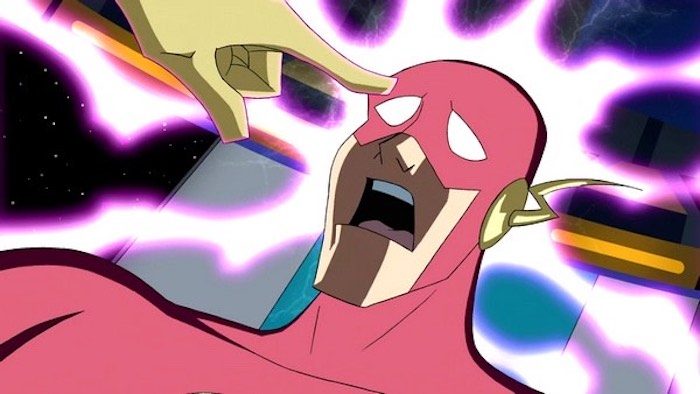
11. “The Great Brain Robbery” – Justice League Unlimited, Season 3
A superhero twist on the Freaky Friday formula where The Flash and Lex Luthor switch bodies was not something I expected to see in the middle of the third and final season of Justice League Unlimited, but often the most ridiculous episodes are the most entertaining. Justice League is a team-based show, and even in world-ending scenarios, the characters can’t help but riff on each other or to comment on the absurdity of the situation. Most of the offhand jokes come from The Flash, the self-proclaimed comic relief of the team, and the only one who seems to be having the most fun when he’s not awkwardly flirting with other heroes or selling out with his energy bars.
“The Great Brain Robbery” pits Flash’s foolishness against the unforgiving and vainglorious Lex Luthor, who has overtaken Grodd as head of the Legion of Doom and also steals his girlfriend, Tala, who tries her best to warm up to the coldhearted villain. When Doctor Fate tries to locate the whereabouts of Grodd through Flash’s mind, his mystical powers accidentally intercept Lex’s own mind-probing of Grodd, which causes the minds to switch. There’s no real sound logic to it (which is why it’s perfect to get Fate involved), but it serves as a perfect scene-stealing opportunity for Clancy Brown and Michael Rosenbaum to play against type. Of course it wasn’t really against type for Michael Rosenbaum who notably already starred as Lex on the hit show Smallville. His Flash-Lex hits all the humorous beats as he fumbles around like an idiot all while trying to play the role of an evil mastermind. Meanwhile on the Watchtower, Doctor Fate immediately figures out Lex-Flash isn’t really The Flash and Lex has to adapt on the fly using Flash’s superspeed powers to find a way out. Luthor’s take on Flash is more sinister than awkward. He shows why Flash is one of the more unstoppable Leaguers when his powers are at full potential.
Let’s be real. We know why this episode is among the 15 best episodes. It’s for two scenes that take place in a bathroom. Even non-watcher have probably seen these scenes retweeted or shared on their social media. The first has Flash-Lex in the bathroom ready to leave when Polaris stops him, asking him if he’s going to wash his hands. Flash-Lex pauses for a bit, smiles and says “No. Because I’m evil.” It’s hilarious in a “this-is-how-a-kid-thinks-a-grown-up-acts” in terms of villainy. The second has Lex-Flash staring at himself in a mirror, catching his breath, and realizing this brain-mishap will finally let him know the secret identity of The Flash. He takes off the mask, stares at the red-headed person in the mirror and says, “I have no idea who this is.”
Continue Reading Justice League >>
The post The 15 Best Episodes of ‘Justice League’ and ‘Justice League Unlimited’ appeared first on /Film.
from /Film https://ift.tt/3dcZKJs
via IFTTT
Comments
Post a Comment